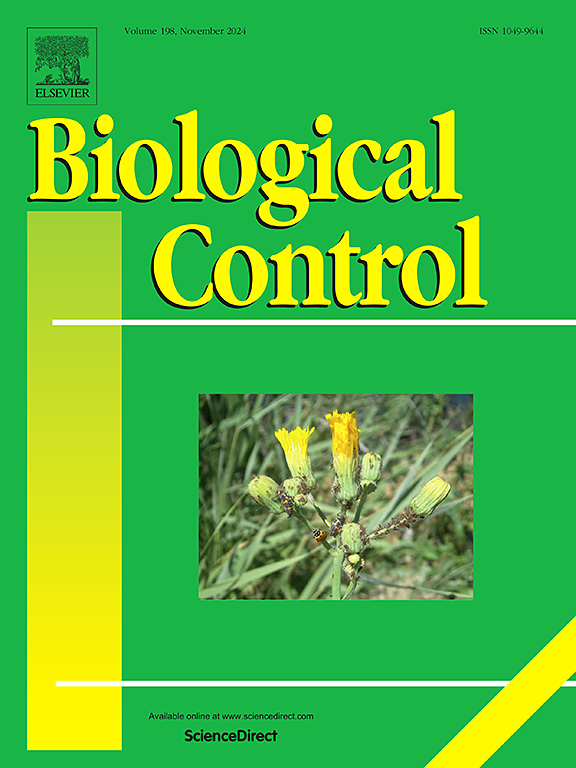Enhanced efficacy of pheromone-treated entomopathogenic nematodes against whiteflies in foliar applications with a gel adjuvant
IF 3.4
2区 农林科学
Q2 BIOTECHNOLOGY & APPLIED MICROBIOLOGY
引用次数: 0
Abstract
The whitefly, Bemisia tabaci, has a diverse host range that includes many economically important crops. Plant damage and crop loss resulting from infestations of this insect pest averages >$140 million (USD) annually in the southeast U.S. and requires different management approaches. Entomopathogenic nematodes are biological control agents targeting insect pests. The entomopathogenic nematode Steinernema feltiae is particularly virulent against B. tabaci and several other insect pests with aboveground life stages. However, unpredictable efficacy limits the use of entomopathogenic nematodes in aboveground/ foliar pest management strategies. Ascaroside pheromone extracts have been shown to significantly improve the efficacy of entomopathogenic nematodes under field conditions that challenge their survival and efficacy. The objective of this study was to evaluate the influence of ascaroside pheromones on Steinernema feltiae in foliar applications against B. tabaci. Cotton plants were selected as hosts for whiteflies, and 5 ml solutions of nematodes (with and without other treatments) were used for foliar applications. Evaluations occurring through laboratory and cage trials were sampled across seven days. Exposure to the pheromone treatment resulted in higher S. feltiae efficacy as marked by higher B. tabaci adult mortality up to 79.98 % and reduced B. tabaci nymph survival down to 5.92 %. In earlier aboveground trials using entomopathogenic nematodes, Barricade® (a gel) facilitated higher efficacy by reducing the risk of desiccation. Barricade® was included in foliar applications for comparison and the gel improved entomopathogenic nematodes’ efficacy in foliar applications. This study highlights a new avenue for the foliar application of entomopathogenic nematodes with enhanced efficacy.

凝胶佐剂在叶面应用增强信息素处理的昆虫病原线虫对抗白蝇的功效
白蝇,烟粉虱,有多种寄主范围,包括许多经济上重要的作物。在美国东南部,这种害虫每年造成的植物损害和作物损失平均为1.4亿美元,需要不同的管理方法。昆虫病原线虫是一种以害虫为目标的生物防治剂。昆虫病原线虫对烟粉虱和其他几种具有地上生命阶段的害虫具有特别的毒力。然而,不可预测的功效限制了昆虫病原线虫在地上/叶面害虫管理策略中的使用。天冬苷信息素提取物已被证明可以显著提高昆虫病原线虫在野外条件下的生存和功效。本研究的目的是评价在叶面施用天冬苷信息素对烟粉虱的影响。选择棉花植株作为白蝇的寄主,在叶面施用5毫升线虫溶液(有或没有其他处理)。通过实验室和笼子试验进行的评估在7天内取样。暴露于信息素处理后,烟粉虱成虫死亡率可达79.98%,若虫存活率可降至5.92%。在早期使用昆虫病原线虫的地面试验中,Barricade®(一种凝胶)通过降低干燥的风险提高了效果。Barricade®被纳入叶面应用进行比较,凝胶改善了昆虫病原线虫在叶面应用中的功效。本研究为昆虫病原线虫的叶面应用开辟了一条新的途径。
本文章由计算机程序翻译,如有差异,请以英文原文为准。
求助全文
约1分钟内获得全文
求助全文
来源期刊

Biological Control
生物-昆虫学
CiteScore
7.40
自引率
7.10%
发文量
220
审稿时长
63 days
期刊介绍:
Biological control is an environmentally sound and effective means of reducing or mitigating pests and pest effects through the use of natural enemies. The aim of Biological Control is to promote this science and technology through publication of original research articles and reviews of research and theory. The journal devotes a section to reports on biotechnologies dealing with the elucidation and use of genes or gene products for the enhancement of biological control agents.
The journal encompasses biological control of viral, microbial, nematode, insect, mite, weed, and vertebrate pests in agriculture, aquatic, forest, natural resource, stored product, and urban environments. Biological control of arthropod pests of human and domestic animals is also included. Ecological, molecular, and biotechnological approaches to the understanding of biological control are welcome.
 求助内容:
求助内容: 应助结果提醒方式:
应助结果提醒方式:


